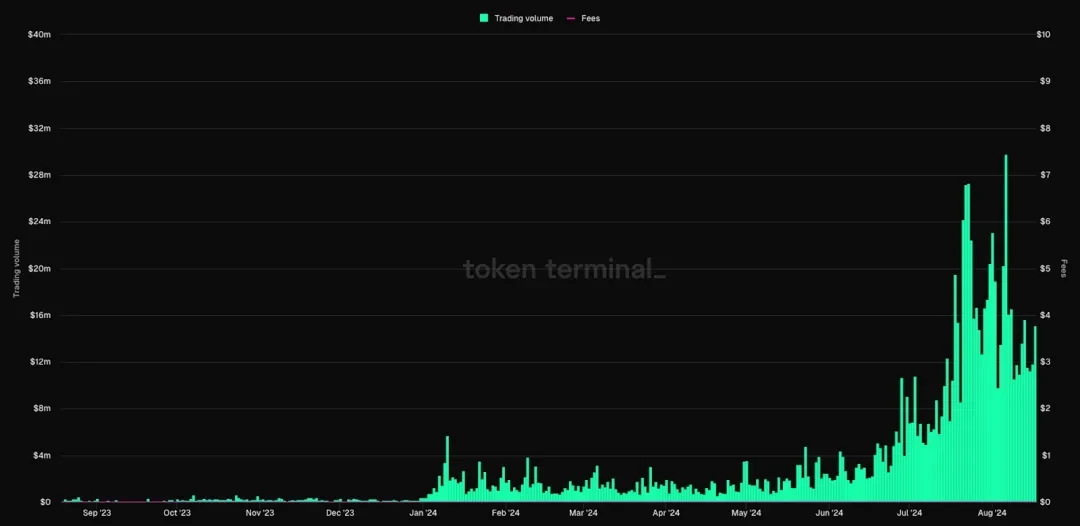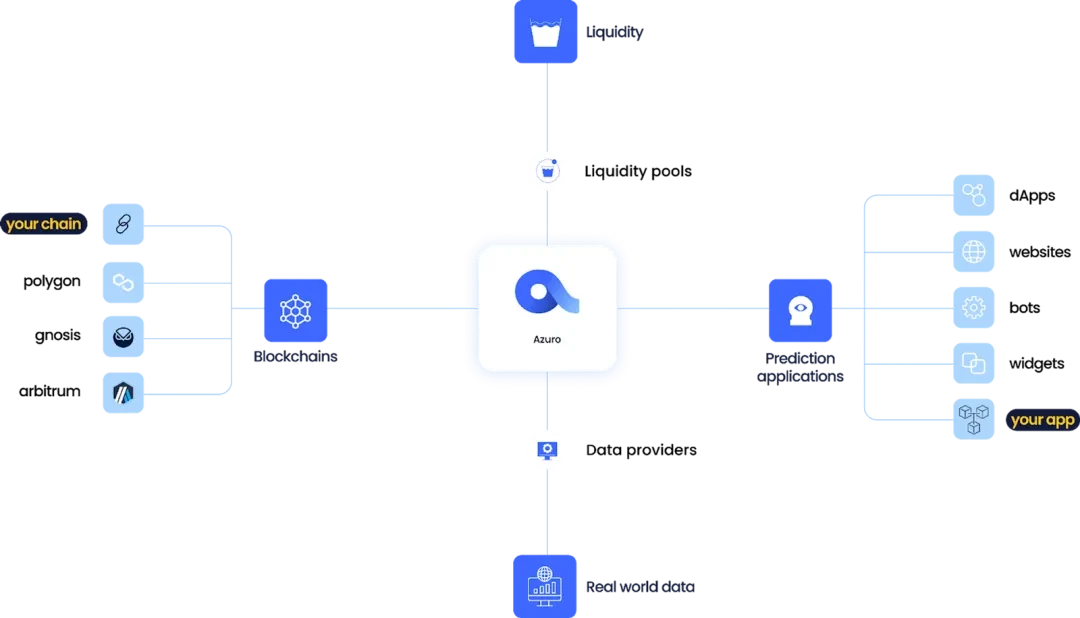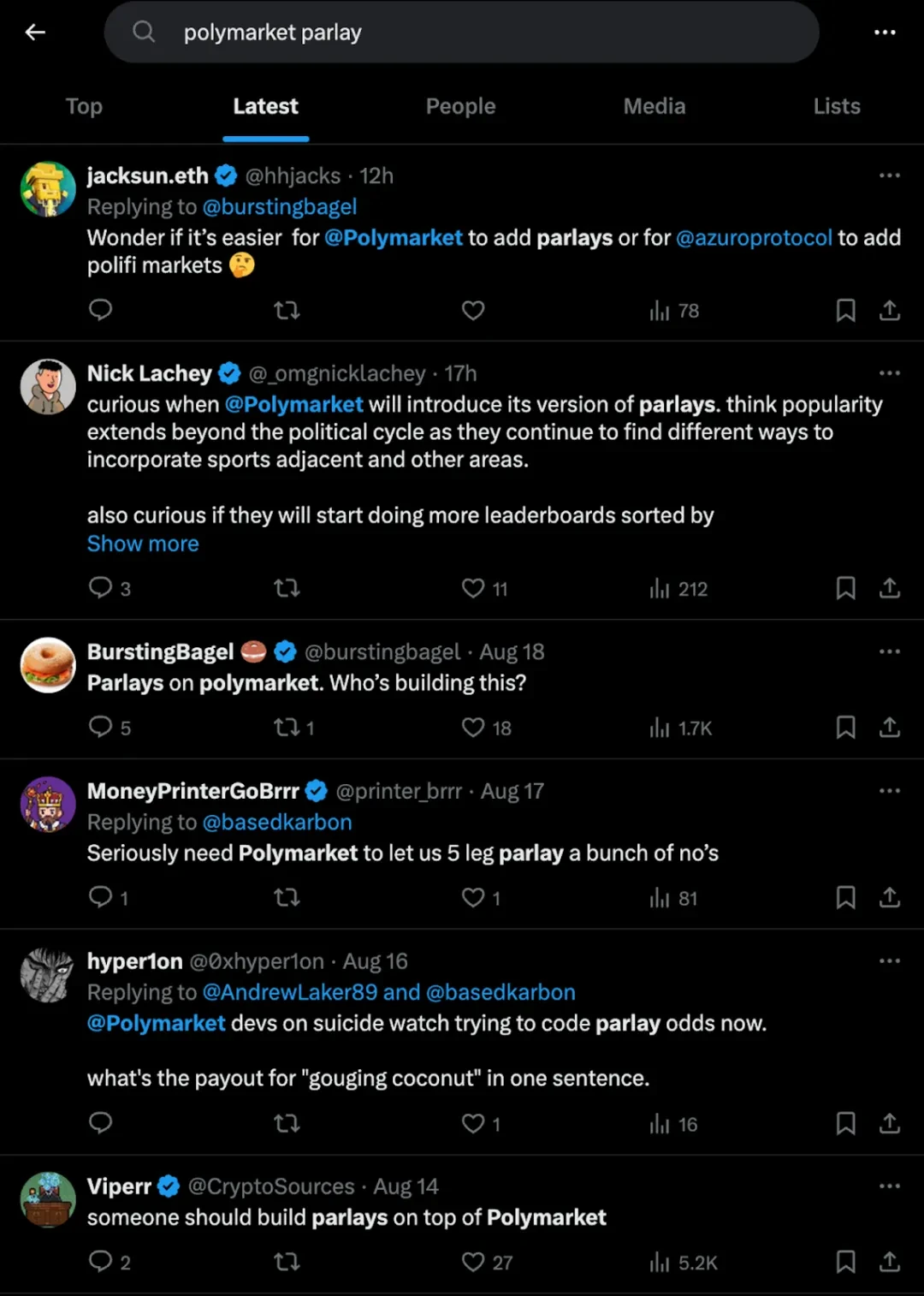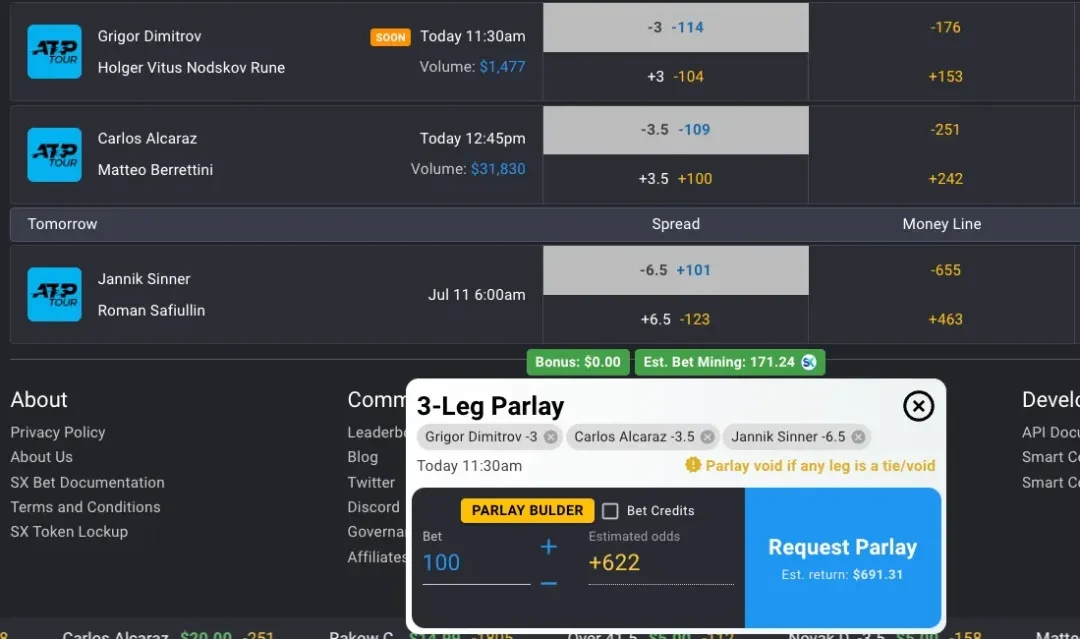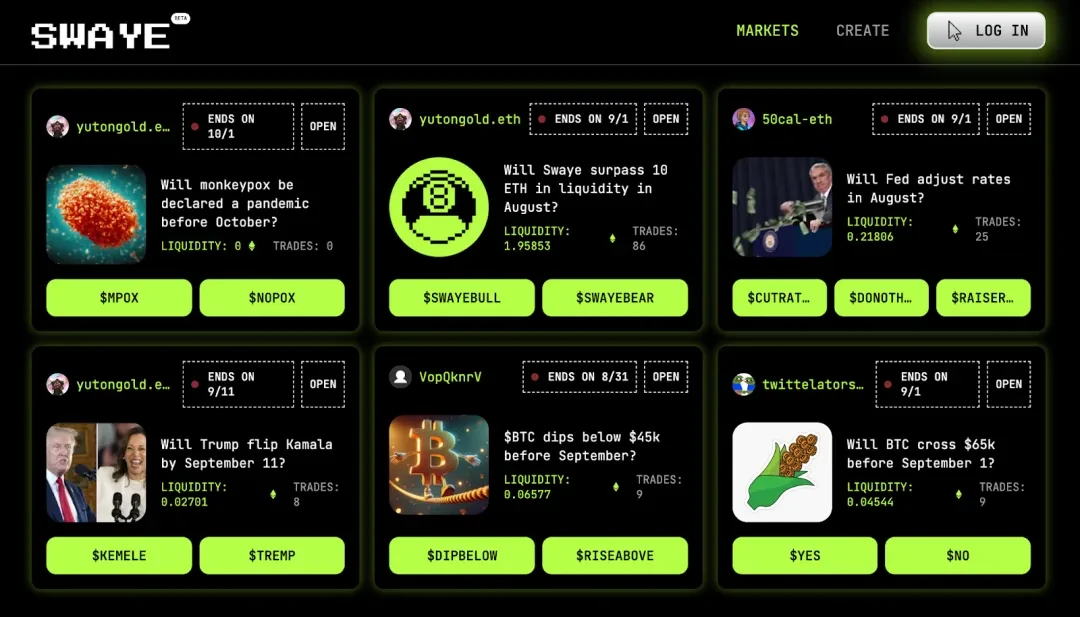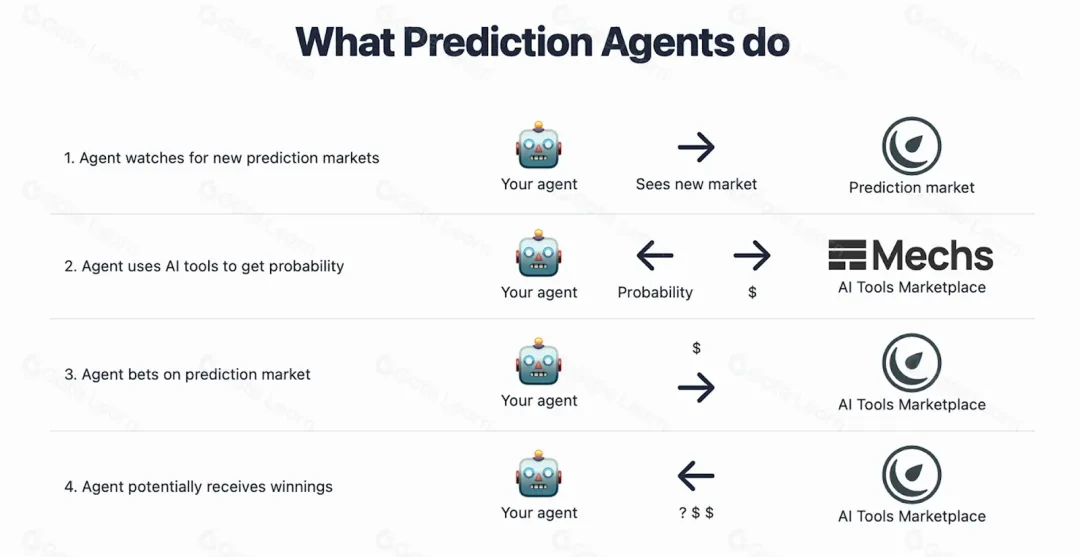اصل مصنف: IOSG وینچرز
Prediction markets are revolutionizing the way reality is predicted by leveraging blockchain to capture and aggregate information from different participants. These platforms embody the principle of crowd wisdom and create efficient markets where participants express their beliefs in the form of bets and truly participate in the process.
The growth of these platforms is astounding. Leading the way, Polymarket’s volume surged to $360 million in July 2024, a fifty-fold increase from its 2023 average. This surge is directly tied to the events of the US presidential election, with over 99% of bets focused on predicting the outcome. However, outside of the political heat, you’ll also find markets predicting the first $1 billion cat memecoin or the next viral TikTok theme.
Source: Token Terminal
As these markets mature, more innovation emerges and huge growth potential emerges, which also raises the question: what will the next generation of prediction markets look like? Whether through technological advancements, improved user experience, or expansion into new scenarios, the future of Web3 prediction markets is expected to optimize and change the way we collectively predict and face emerging trends.
1. Difficulties in predicting the market
1.1 Liquidity and market making problems
1.1.1 The Dilemma of Long Tail Events
Pricing rare events such as a prediction market on when habitable exoplanets will be discovered is a classic long-tail problem. The uncertainty and speculation of the outcome lead to low liquidity. In prediction markets, highly fragmented events often have difficulty attracting participants, resulting in thin order books and limited trading activity. This lack of liquidity makes it difficult for traders to place orders, which ultimately weakens market efficiency and causes these potentially hot but slow-moving prediction markets to be ignored.
1.1.2 Impermanent loss of liquidity providers
Liquidity providers (LPs) — participants who provide assets to the market’s liquidity pool to facilitate transactions — face significant risks due to impermanent loss. For example, in a prediction market such as whether a candidate will win an election, the price of the associated token will move closer to zero or one as the outcome of the event becomes more certain. LPs who provide liquidity early may hold too many tokens of “failed” predictions, which will eventually return to zero, resulting in huge impermanent loss.
1.2 User Engagement and Market Attractiveness
1.2.1 Insufficient upper limit
In the crypto world, everyone is chasing the next 10 0x opportunity, which makes prediction markets seem relatively ordinary. For example, instead of betting on Trump vs. Kamala Harris on a prediction market, many people may prefer to invest in memecoins like $TREMP or $KAMA, which offer unlimited potential and more adrenaline. For competition, prediction markets can introduce gamification elements, such as dynamic event-specific markets or reward systems, as well as loyalty programs or tiered rewards to enhance user engagement and make the process of seeking the truth as exciting as speculating on memecoins.
1.2.2 Market Diversity and Long-term Nature
Prediction markets need to diversify beyond political events to maintain long-term user engagement. While there are already established niche markets in sports and entertainment, the opportunity lies in creating specialized markets that cater to specific interests, such as predicting when ChatGPT-5 will be released. However, a common criticism of this is that even within broader topics, users may only focus on specific topics, making these markets highly seasonal.
Additionally, markets take a long time to run and have uncertain outcomes, which can discourage user participation. Many topics take a long time to conclude and there are no clear criteria for winning or losing, which can make it difficult to attract sustained user interest. To address these challenges, prediction platforms should focus on quickly creating and closing market segments that match user interests, balancing the need for user participation with the feasibility of prediction markets.
1.3 Regulatory barriers
Regulation remains a significant barrier to the development of prediction markets. The U.S. Commodity Futures Trading Commission (CFTC) fined Polymarket $1.4 million in 2022, demonstrating the risks of operating an unregistered platform. This regulatory action resulted in Polymarket banning U.S. users from using its platform in order to comply with the settlement agreement. However, the challenges are far from over, and recent developments have brought election-related prediction markets under greater scrutiny. Most recently, in 2024, the CFTC proposed a rule that would ban derivatives trading on U.S. elections, arguing that such markets could potentially influence election results.
Source: CoinDesk
This proposed ban has serious implications for platforms that rely on political betting markets, such as Polymarket, PredictIt, and Kalshi. Senator Elizabeth Warren has also publicly urged the CFTC to shut down election prediction markets entirely, citing concerns that these markets could disrupt the democratic process. These platforms are currently involved in legal proceedings to fight these regulatory measures.
This situation highlights the delicate balance that prediction markets must maintain between innovation and compliance. As the regulatory environment becomes more complex, these platforms will need to adapt or face significant operational restrictions that could inhibit the growth and diversification of this emerging industry.
2. Next Generation Prediction Markets
Despite the challenges facing prediction markets today, a new wave of prediction market innovation is on the horizon. The next generation of prediction markets are being designed specifically to address these obstacles, incorporating advanced technology, enhanced market mechanisms, and user-centric features. Designed to overcome challenges with liquidity, user engagement, and regulatory restrictions, these upcoming platforms could change the prediction market landscape, paving the way for a stronger and more dynamic future.
2.1 Advanced Market Mechanism
2.1.1 Specialized liquidity solutions
Dedicated market makers can unlock a wealth of collective knowledge by providing liquidity for complex outcomes. An example of innovation in this space is the peer-to-peer liquidity model employed by projects such as Azuro. This model pools capital into a single counterparty to respond to the needs of platform traders, ensuring that even niche markets have enough liquidity to operate effectively. This system supports a wider range of prediction markets and makes it easier to maintain liquidity during long-tail events.
This approach is particularly useful for markets that predict rare or highly specific events, such as the impact of a technological breakthrough. By pooling liquidity from different participants, this model spreads risk across multiple markets, reduces the likelihood of liquidity shortages, and enhances the overall robustness of the platform.
Source: Azuro
2.1.2 Leverage and combination betting
The ability to win in a wider variety of ways is particularly attractive to prediction market participants, which is where advanced betting strategies such as leveraged betting and combination betting come in. Leveraged betting allows participants to increase their potential returns by increasing the amount they bet, which is particularly attractive in high-risk markets such as political predictions.
Source: CT
Combination betting combines multiple predictions into one bet, offering the chance of a higher return. For example, users can combine bets on multiple related economic events, such as interest rate changes and inflation data within a quarter. The interconnectedness of these events increases potential returns, but also comes with higher risks.
The social aspect of combination betting brings another layer of excitement. Participants can share combination betting slips on social media, potentially creating virality when someone wins a jackpot. This can drive more participation, especially in the crypto community. However, the management of large gains, the risks associated with payouts and how to set accurate odds remain a challenge.
The peer-to-peer combination betting system implemented on the Web3 sports betting platform SX Bet allows users to create customized bets, with liquidity provided by automated market makers. This innovation brings more dynamic and attractive prospects to prediction markets in various fields.
Source:SX Bet
2.1.3 Permissionless Market Creation
Permissionless markets created by users have the potential to significantly expand the range of predictable events. By allowing anyone to create markets, platforms can tap into predictive power in unexpected areas. For example, niche audiences may create markets predicting the success of a particular meme or the outcome of a specific event, which would typically be ignored by larger platforms.
Swaye is innovating in this space by allowing users to create markets tied to event outcomes, and participants can even create or trade memecoins tied to those outcomes. Users frustrated by the high opportunity costs and inability to create markets on traditional platforms can turn to Swaye, where they can generate markets and earn fees. For example, a user might create a market predicting whether the monkeypox virus will be declared a pandemic by a certain date. Outcome tokens, such as $MPOX and $NOPOX, will represent possible outcomes, with failed tokens going to zero and successful tokens potentially becoming permanent memecoins.
Source: Swaye App
2.2 Enhance user experience and engagement
2.2.1 Mobile First and Real-time Prediction
Optimizing for mobile is critical to capturing real-time insights. Imagine a mobile prediction market experience where users can interact and place bets during real-time events, such as sports games or political debates. Notifications and real-time updates keep users engaged, allowing them to make predictions and see results instantly, anytime, anywhere.
2.2.2 Integration with social networks
Leveraging existing social media channels is an effective way to attract more users and boost participation in prediction markets. By integrating with platforms like Farcaster and Solana’s Blink, prediction markets can leverage established networks for distribution and user interaction. Projects like Swaye and Bookie are already moving in this direction, enabling users to share their predictions directly in social feeds, creating viral moments and driving engagement.
Source: /swaye on Farcaster
This integration could make prediction markets more accessible and appeal to a wider audience, as users can seamlessly participate in predictions shared within their social circles.
2.2.3 Gamification and social dynamics
Gamifying prediction markets can further enhance their appeal, transforming them from a boring activity into an engaging competition. Features such as leaderboards, achievement systems, and competitive leagues can significantly drive user engagement. Imagine users participating in a social prediction league, earning badges and climbing the rankings based on accuracy. KOL-led predictions can add another layer of social attributes, with KOLs sharing their bets and encouraging their fans to join and compete, deepening community participation and interaction.
2.3 AI Integration
AI is poised to revolutionize the prediction market landscape, solving long-standing challenges and unlocking new possibilities. As Ethereum co-founder Vitalik Buterin suggests, the intersection of AI and cryptocurrency, particularly in prediction markets, could be the “holy grail of cognitive technologies.”
2.3.1 Content creation and event selection
AI can significantly improve the process of creating events in prediction markets. By analyzing trends in news, social media, and financial data, AI can capture relevant topics in a timely manner and capture the publics current interests. For example, AI can identify emerging global issues, such as sudden geopolitical conflicts or technological breakthroughs, and use these as prediction market topics to ensure that market dynamics are consistent with current prediction market topics.
2.3.2 Market Making and Liquidity
AI-driven liquidity management is gaining traction in prediction markets. While specific implementations are still evolving, AI may eventually play a key role in dynamically adjusting liquidity depth and pricing in real time. By monitoring market activity and sentiment, AI can optimize liquidity provision, reduce slippage, and enhance market stability. This approach is particularly valuable in markets where liquidity demand fluctuates rapidly.
2.3.3 Information aggregation and analysis
AI systems could quickly process large amounts of data and provide comprehensive forecasts, transforming prediction markets into the go-to source for informed decision making. By aggregating data from a variety of sources, such as economic indicators, public sentiment, and historical trends, AI could provide highly accurate forecasts, making prediction markets more reliable and insightful.
For example, Polymarket’s recent integration with Perplexity will allow for the aggregation of search engine and social media sentiment, creating news summaries for users and providing visual data to help users make more informed decisions.
2.3.4 AI as a market participant
The role of AI as an active participant in prediction markets is expected to expand significantly. Platforms like OmenETH have demonstrated how AI bots can trade alongside humans, increasing market depth and improving prediction accuracy. These AI bots are particularly good at identifying and exploiting price discrepancies, helping to keep markets consistent and efficient.
Source: Gate.io
The potential of AI is not limited to trading. By participating in niche and long-tail markets — such as predicting the outcome of a specific scientific breakthrough or the impact of new regulation on a niche industry — AI can make these previously illiquid markets more viable. AI systems, with their ability to process large amounts of data and respond quickly to new information, can ensure that these specialized markets remain active and attractive to participants. One project working to allow the construction of these AI agents is Autonolas.
Additionally, AI has the potential to revolutionize dispute resolution in prediction markets. AI-driven systems can provide fair and efficient adjudication in disputed outcomes (such as close elections), reducing the time and costs involved in traditional human arbitration.
2.4 ZK keeps predictions private
In prediction markets, privacy is more than just about keeping bets secret; it is essential to ensuring that the market functions properly. If everyone can see each other’s predictions, there is a risk of copying the most successful predictors, which could weaken the diversity of opinion in these markets.
To address this, platforms can use privacy-preserving techniques to keep predictions confidential until the outcome of an event is revealed. For example, a method called commit-reveal allows participants to submit predictions in a way that remains hidden until the outcome is revealed. This process is similar to sealing your prediction in an envelope that can only be opened by the blockchain at the right time.
Platforms can also implement advanced cryptographic techniques, such as zero-knowledge proofs (ZKPs), to provide stronger privacy guarantees. These methods ensure that predictions remain anonymous without sacrificing market transparency and security. Although these techniques are very powerful, they also have some trade-offs, such as increased computational costs, which platforms must carefully weigh.
3. نتیجہ
As the 2024 election cycle winds down, the future of prediction markets is at a critical crossroads. Optimistic views suggest that these platforms will expand into diverse fields such as finance, technology, and science, thanks to innovations such as artificial intelligence integration and advanced market mechanisms. This evolution could transform prediction markets into an essential tool for decision-making, allowing collective intelligence to shape the future.
However, a pessimistic view is that prediction markets face significant challenges. Prediction markets often face limited demand, insufficient passive capital inflows from savers, and insufficient participation from key players (such as more astute traders). This, coupled with competition from traditional financial instruments and regulatory pressures, may limit their growth.
During major political events, trading volume is concentrated in a few key markets, raising questions about sustainability. User engagement is likely to drop sharply after the 2024 elections. This could make it difficult for prediction markets to maintain growth momentum and expand their utility beyond speculation.
Despite these challenges, the potential for prediction markets to redefine how we predict and shape the future is undeniable. The road ahead is full of uncertainty, but if these platforms can rise to the challenge, they could become the cornerstone of a new era—one in which collective intelligence is not just a tool for speculation, but a force that drives the course of history.
This article is sourced from the internet: IOSG Ventures: Challenges and innovations facing the Web3 prediction market
Original|Odaily Planet Daily (@OdailyChina ) مصنف: وینسر (@wenser2010 ) آج صبح، فرانسیسی ٹی وی نے انکشاف کیا کہ ٹیلی گرام کے بانی اور سی ای او پاول ڈوروف کو فرانس کے ہوائی اڈے پر گرفتار کیا گیا اور انہیں فراڈ، منی لانڈرنگ اور دہشت گردی سمیت متعدد الزامات کا سامنا ہے۔ اس خبر سے بازار میں کھلبلی مچ گئی۔ FTX حادثے کے لیے SBF کو جیل بھیجے جانے کے بعد اور CZ کا منی لانڈرنگ کے لیے امریکی حکام سے معاہدہ طے پا جانے کے بعد، Pavel Durov تقریر کے لیے سزا یافتہ ہونے کی ایک اور مثال بن گیا۔ روسی سیکیور انٹرنیٹ الائنس کی سربراہ ایکاترینا میزولینا کے مطابق، پاول دوروز کی گرفتاری امریکہ کی جانب سے ٹیلی گرام پر گردش کرنے والی سپر کرنسی ٹن کوائن (TON) پر کریک ڈاؤن کرنے کی درخواست تھی تاکہ امریکی SEC کی سابقہ پابندیوں کی پالیسی کو جاری رکھا جا سکے۔ کیا عروج پر TON ماحولیاتی نظام کو دوسرا تباہ کن دھچکا لگے گا؟ کیا کرے گا…
